In the present day era of digitization, ‘Content is the King’. No matter how many times you hear this, its importance is always more than it was the last time you heard it. More so, because of the constantly changing algorithms of Google. Today, creating the best content for your readers is as important as coming up with the best product or service in your industry. After all, content is what brings a prospective client to your business, and content is what helps make the final sale.
It wouldn’t be wrong to say that more or less all of us are fully aware of the importance of great content. However, the question here is, how to actually create compelling content for your reader or potential customers? Well, this is what we’re about to find out, in an elaborate manner, if we may say so. But, before we begin, let us understand the purview of this write-up. It includes some of the essentials of a compelling content copy, followed by the nuances related to 4 pillars of good content which are –
-
Meta Titles and Meta Descriptions
-
H1/H2s
-
Keywords
-
Composition
Content is attractive and interesting to read
- Use of Correct Company Name
The importance of the correct name and spelling of the business or company for which the content is being written is paramount. The Name is the first element which helps a layman identify the business, and what it stands for. If spelled wrongly/incorrectly, it may lead to unwanted confusions, and eventually to the weakening of the company’s standing.
Notice, how in the below example, YouTube is written correctly with a capital Y and T, thus helping the business to establish a distinct individuality for itself.
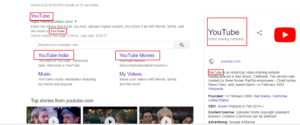
- Use of ‘We’ or ‘Us’
A web content is essentially a monologue from the business that addresses its prospective clients. Hence, it is best if We, Us, or Our, are used when the business is being referred to. In case of blogs and articles, one can feel free to use I. That being said, one must be aware of the fact that the reader is more interested in what is being offered to him rather than knowing who is behind the business. This makes it important to keep the use of first-person pronouns to a minimum and concentrate instead on the use of You or Your.
-
Use of Clear, Direct and Objective Language
When it comes to writing content that interests the user, it is best to eliminate Fluff or promotional text, as many of us call it. Getting a bit subjective and promoting one’s products and offerings might be tempting, but always remember it is the actual information that the reader derives which matters. Moreover, a crisp and to-the-point copy makes for a significantly better composition.
Of course, this doesn’t mean you can’t be clever or humorous in your way of presenting content. There’s nothing wrong with being creative, but then, beware of becoming too personal or subjective with the language.
- Provision of Instant Gratification
With the average attention span of a user decreasing at a drastic rate, it is in your best interest to ensure that your most important information is offered first. Not only will it convey to the user that he is at the right place, but will also help you get him hooked. Once that is being taken care of, you can offer certain background information. Technically, this is known as the ‘Inverted Pyramid’ method. It propagates that you must offer the big picture first, and the details can come in at a later point. So, tell your readers what is it that you do, and what can you offer them. Information regarding your inception as a business can be conveyed down the line.
- Use of Unique, Fresh and Up-To-Date Content
There is no better way to impress your readers as well as Google’s algorithm than using unique content. When we say unique, not only do we mean distinct from what others are offering, but also original in ideas and language. Furthermore, it pays off to update your content every once in a while, since the most recent content is the one that gains a better rank on SERPs. And a better rank will eventually help you get greater traffic.
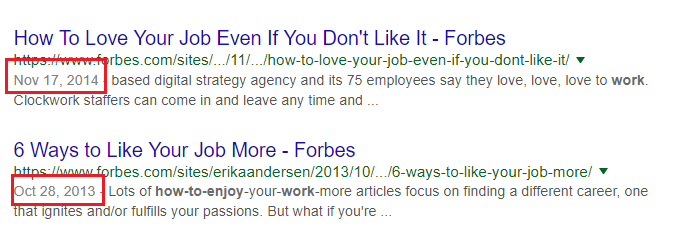
Notice how in the above example, a piece of content date more recently enjoys a better rank in the search results. (This may not be the case always, as ranking depends on numerous other factors as well. However, it is an imperative aspect that shouldn’t be ignored)
Remember, with every update, Google’s algorithm is getting more stringent and intolerant towards content that is duplicated, low in quality or simply too old to be relevant anymore. Don’t believe us? Simply think about why you don’t see articles from Ezine.com anymore in your regular search results. The answer. Poor quality of content. Need we say more?
-
Use of Correct Grammar and Spellings
Your content is your primary and to a large extent the only way for you to actually converse with your readers. And while you may want to sound candid, you cannot take the risk of coming out as unprofessional or reckless. It is therefore, extremely important to ensure that your content is free of any grammatical or spelling errors. Once your copy is ready, it is recommended that it is proofread, more than once. If possible have more than one person undertake this task.
Errors, even if as simple as typos, may adversely affect the way a reader perceives your business. Not only will it may you look negligent, but will also put a question to your credibility and ability to handle imperative functions of the business.
Then again, incoherent sentence structure may confuse the search engines and consequently hurt your search rankings. Needless to say, you should leave no stone unturned to ensure that your content flaunts impeccable grammar, correct punctuations, and accurate spellings.
-
Use of Short Sentences
Web Content is extremely different from the kind of content you will find in a best-selling novel. As mentioned earlier, the attention spans of readers on the web are incredibly low. Hence, you cannot risk losing their interest due to long, illegible sentences. And one-sentence paragraphs are a strict no-no.
Keep your sentences short and perky, even if you need to start a sentence with But, And, Also. For what it’s worth, even keep your paragraphs concise. Use paragraphs that come to an end after the third or at best the fifth sentence. Even solo sentences are a great idea.
The Pillars of Compelling Content
Meta Titles
A Meta Title is basically the text that is visible in the search listings. It is not just the link to the particular webpage but also acts as the title of a browser tab. A Meta Title often looks something like – ‘Best Way to Increase YouTube Views’ or ‘ABC – California’s Premier Engineering Institute’
A good Meta Title usually serves the following purposes –
-
Provides a short description of the webpage.
-
Helps the search engine infer the page content.
-
Aids the improvement of click-through rates.
-
Acts as the title of a browser tab, thereby helping the users shuffle multiple pages with added ease.
This is a fine example of an impressive and effective Meta Title. It tells you what the page is about, offers the summary in the form of rating, and gives you a hint of the tone of the article. Moreover, it is short and snappy.

Let us throw some light on the aspects that help make a Meta Title truly compelling.
- Obligatory Elements
Ideally, a Meta Title should be accurately descriptive, rich in keywords and concise. It should also spill out the name of Brand/Business. Something in the form of
Primary Keyword – Secondary Keyword | Brand Name
Churros Recipe – Easy Homemade Churros | Mommy’s Home Cooking
- Ideal Length
It is often recommended that Titles should be somewhere between 55 to 60 characters. However, in the exact sense, the ideal length of a Meta Title should be such that it fits a 600-pixel container. This implies that the actual length will depend on the fonts size as well as the mix of letters used. For instance, the let ‘I’ will take up much less space than the inherently wide letter ‘w’, thus impacting the size of the titles. Then again, uppercase letters and words with apostrophes use comparatively greater space. It is thus advised, to use lowercase letters to enjoy more space. It will make your title more ‘Google Friendly’ and will, therefore, help your SEO efforts.
- Visibility
As mentioned above, more often than not, Google displays titles up to 60 characters in length rather efficiently. However, the chances of that holding true are still only about 90%.
- Sticking Out From Competition
In order to rank better and capture the attention of your reader, right from the first go, it is best to use an original Meta Title for all your webpages. It may seem cumbersome, but will prove to be highly rewarding.
- Use of UTF8 Characters
For all those creative heads out there, you can revel in the fact that Google now officially supports certain emoticons. While that may seem to be an exciting avenue, there are some aspects you should be wary about –
- Ensuring that a Meta Title with UTF8 Characters has a high-impact on SERP is an extremely cumbersome task, and in most cases, may not be worth the effort.
- It is imperative that the symbol or character used is relevant and easily relatable for the users.
- In some cases, the symbols may overshadow the actual words used in the title. Hence, it is important for these to be worth the risk.
- Characters may or may not render equally well across all devices, and should, therefore, be tested before implementation.
Meta Description
A Meta Description refers to a short snippet or a tag in HTML, which offers a summary of the content on a webpage. More often than not, search engines show the Meta Descriptions as a part of search results, when the searched phrase resonates with the description. For what it’s worth, a Meta Description forms an important element of on-page SEO.
Now here’s an example of a good example of a good Meta Description. Not only is it concise, but also tells the user exactly what he can expect from the page.

Let us throw some light on the aspects that help make a Meta Title truly compelling.
- Obligatory Elements
Meta Descriptions should be accurately descriptive and rich in keywords while helping the user analyze whether or not the content on the webpage is relevant to what he is seeking. These descriptions must be considered the key to improving click-through rates. They should, therefore, offer unique and informative summaries that can be relied upon.
- Ideal Length
While there is no prescribed length for Meta Descriptions, but it is a common observation that search engines truncate the snippets which are longer than 160 characters. Though they need to be kept short, it must be ensured that they effectively convey the requisite information.
- Display of Meta Description v/s Text from Page
Even when efforts are taken to write down unique Meta Descriptions, in some cases, the descriptions get overruled by Google. This usually happens, when the search engine’s crawlers are unable to judge whether or not does the description adequately describes the content of the page. In such a situation, the crawler identifies a snippet from the target page that best matches searched keyword or phrase.
- Sticking Out From Competition
For a page to get a better click-through rate, it is extremely essential that its description is fairly distinct and more eye-catching than the competitors’. The most promising way to ensure this is by writing descriptions that are original as well as informative.
- Use of UTF8 Characters
In a recent move, Google has given a green signal to the use of symbols and special characters in Meta descriptions. Some webmasters believe that it can prove to be of help in improving the click-through rates, due to the enhanced visual appeal. However, it must be noted that the more these symbols are used, the lesser effective they will become. At one point in time, when a large number of webmasters will start using them, these symbols will completely lose the edge that they offer today.
H1s/H2s
H1, H2, H3…H6 are nothing but short for Header Tags ordered numerically. Like Meta titles and Meta descriptions, H1/H2s also act as important aspects of on-page SEO. The primary objective of these header tags is to convey a brief about the website’s content to the search engines. Needless to say, the search engines consider the header tags to be far more important than any other tags. As must be obvious, the importance of H1 is higher than that of H2; that of H2 is greater than H3 and so on. Essentially the header tags act as the support system to your website’s theme.
Here’s an example of a good header tag. While the H1 marked in yellow, offer precise information about what the business offers. The H2 describes the service in a clear and concise manner, thus letting the reader know what to expect in the contents of the page.
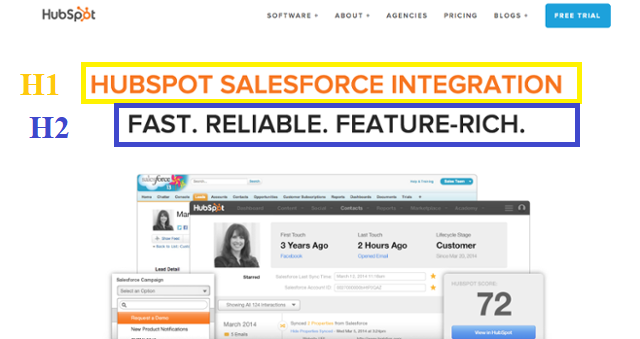
Now that we’re aware of the importance of headers, let us take a quick look at some of the attributes that help in ensuring a good header tag.
- Use of Correct Language
Headers are arguably the most important texts and play an important role in guiding your user to the content that he is seeking. Hence, your header needs to be easily understandable, grammatically correct and shouldn’t comprise of any spelling errors. This can’t be stressed enough!
- Integration of Keywords
Yes. Your H1 must contain your targeted keywords so that the search engine is aware of the contents of your page. That being said, you cannot risk using a header that is not accurate or doesn’t resonate with the content that follows. The same holds true for the H2, H3 and so on. However, since these are subheads to the actual header, it is not essential for you to use keywords here.
- Headers and Time Element
Once the layout of your website is ready, you shouldn’t waste any time before you introduce the Header Tags to your content. For what they’re worth, the headers will help the search engines understand what is it that you aim to offer, while also directing your target audience to your website.
Keywords
-
By definition, Keywords are nothing but the topics and contents that define and/or summarise the content of your website, webpage, blog or article. Keywords are arguably the most imperative aspect of SEO, since, it is these words or phrases, that help your website show up on SERPs when a user comes looking for something that you have on offer.
For instance, if you have a website that offers Vegan Recipes, the following may be your keywords –
Vegan Recipes
How to Cook Vegan Food
Vegan Cooking
Vegan Cooking at Home
Plant-Based Recipes
Easy to Cook Vegan Recipes
Note that these words ought to be a part of your website content for the search engines to understand what you offer, and for your website to show up as a result of search queries.
Now that you know what keywords are, let us understand how various aspects related to them can help your website climb the ladder of Search Engine Optimisation.
-
Keyword Research
For you to understand and integrate the apt keywords in your content, it is quintessential to conduct a keyword research first. This can be simply done using a search engine and typing in words or phrases that you think your audience will be looking for. If the results resonate with the type of product or service that you aim to offer, the keywords are apt. if not, you may need to rethink the right keywords. Repeat this exercise a few times until you have a comprehensive list of potential keywords. That being done, you can now go ahead and get in integrated with your f co
-
Keyword Coverage
It is observed that the first 200 words in any type of content are closely scrutinized by search engines. Moreover, these words also help the user understand what the content entails. Hence, special care must be taken that these first words have at least a couple of primary keywords if not more. You can also bold these keywords so that they stand out and help the user get a quick overview of the content.
Now that your introductory text has ample keywords, you must make sure that the body text also encompasses a few keywords, albeit occasionally.
While keywords are important, you should ensure that they are not stuffed unnecessarily, and don’t look out of place.
-
Integration of Long Tail Keywords
Long tail keywords are nothing but keywords comprising of 3 or more distinct words. These type of keywords or key phrases are essentially more specific in nature. Although they’re unable to generate a greater amount of search traffic but ensure a significantly higher conversion value.
A head-keyword, such as SEO Tutorial, may be too generic. However, a long tail keyword such as SEO tutorial Data Visualising is much more specific (as depicted in the example below). Not only will it yield comparatively more relevant search results, but will also help the website target a narrower audience. A promising way to put a primary long-tail keyword to the best use is by using it in the post’s headline. (Again, the example below encompasses this aspect)
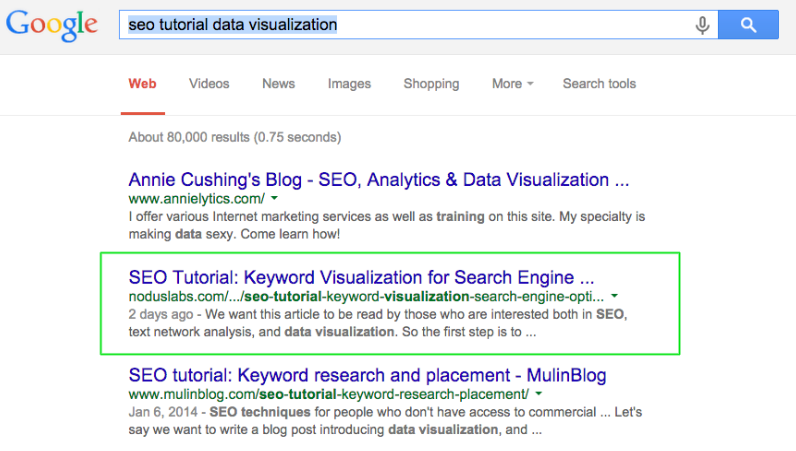
Below mentioned are the benefits of using Long Tail Keywords in both, your headers as well as website content –
-
Thanks to their specific nature, long tail keywords usually face less have less competition thus making it easier for your website to rank higher.
-
When it comes to offering a greater ratio of conversions long keywords beat the generic/head keywords, hands down!
-
-
Keywords and Search Intent
More than an aspect that impacts SEO, search intent is directly correlated to paid search. In order for an online advertising campaign such as PPC or PPM to give efficient results, it is important that the content, as well as marketing strategists, understand the intent behind a user’s search for a product, commodity or service.
The intent may be low-intensity such as navigational or informational. Here the user is ideally in the awareness or research stage and simply wishes to accumulate more information. On the other hand, search intent may be high-intensity such as transactional, wherein the user is at the decision or purchase stage.
These stages are best illustrated by the following graphic:
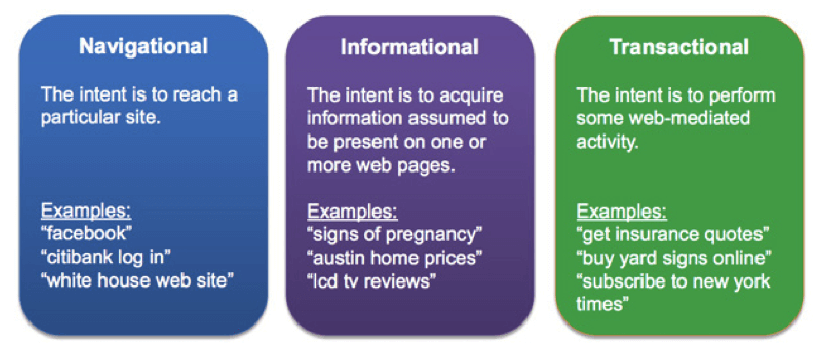
No only intent-driven marketing using appropriate keywords help in increasing the website traffic but also ensures that only highly interested prospects are attracted to the site. Moreover, high-intensity keywords directed at decision and purchase oriented clients are said to have considerably high ROIs.
-
Natural Integration of Keywords
You must have heard this over and over again. The reason behind this is simple. If your content doesn’t flow naturally, chances are search engine crawlers will consider it bogus/low quality and penalize it. Even if that doesn’t happen, your users will feel confused thus increasing the bounce rate of your website.
But how do you use heady keywords such as “SEO agencies Brooklyn” or “artificial ponds for residential properties”? Well, don’t bother to use the exact keywords. Instead, tweak them a little to ensure that they sound natural. Google is smart enough to understand the intent behind your keywords even if they aren’t extremely precise.
For instance, you can go with “ Top 5 SEO Agencies: Brooklyn Companies You Want To Work With” or “10 Thoughts Everyone Has While Looking for Artificial Ponds for Residential Properties”.
Now isn’t that a completely natural sounding and equally creative way of putting keywords to use?
-
Apt Use of Keywords
It is not just your generic text where you need to use the keywords. In fact, your keywords must be used equally compellingly in the below-mentioned elements of your website –
Here are the most important places to add keywords to your website:
-
Page Title Tag
-
First Paragraph Of Text
-
Article/Blog Topic Title
-
Meta Title
-
Meta Description Tag
-
H1, H2, H3…
-
Anchor Text
A good example of consistent use of keywords across these elements is –

Notice how in the Page Title, as well as Meta Description, the primary keywords have been used for a whopping 5 times. Such a phenomenon and natural integration ensure higher rankings on SERPs, without a doubt.
-
Optimal Frequency of Keywords
There was a time when the more keywords a text had, the better was its optimisation. Not anymore. Thanks to the Hummingbird algorithm update by Google, keyword frequency, and density have lost their importance.
In the present day scenario, it is much more about using the keywords in a smart way. This concept is known as “Term Frequency-Inverse Document Frequency”. Here, it is suggested that the content shouldn’t comprise the same keyword over and over again, and must instead have variations of keywords.
For instance rather than using content writing services repeatedly. Keywords such as the ones mentioned below can be used –
This exercise will have the following advantages –
-
It will enhance the readability of the content,
-
It will ensure seamless integration of the keywords
-
Will also increase the variety of keywords, thus leading to greater traffic
Composition of the Website and it Elements
When we speak of the composition of a website or web content, we are essentially pointing at the mix of various elements such as –
-
Static Text
-
Dynamic Content
-
Images/Graphics
-
Videos
However, your interest should not be limited to the fact that these elements are simply present on the page/site. For these to have a favorable impact on our site, we ought to ensure that these elements –
-
Are used in the optimal quantity
-
Are aligned in a visually pleasing manner
-
Help ease of navigation
-
Enhance user interest
-
Lead the user to the take the desired action
Let us take a look at some of the aspects which need your close attention for your website to attract users and rank well, simultaneously.
-
Readability of the Text
Right from naturally flowing language to correct grammar and punctuation, everything about the text elements of your website should be practically flawless. It must be such that the readers understand it in the first go, and are tempted to read more. In order to achieve better readability, you must refrain from-
-
Keyword stuffing
-
Use of overly witty language/puns
-
Use of flowery language
-
Overuse of pop-culture/political/historical or scientific references
-
Value Offered by the Text / Structure of the Text
It is essential for you to offer the user with what he is seeking from your content. Whether it is information about a news affecting the people of his area, or a newly introduced gadget, whatever it is that the user is most likely to want from your website, should be offered to him instantly.
In the example given below, Mercy Health – West Hospital’s helps the user with a perfectly designed set of information including –
-
Full name of the establishment
-
Address (Google Map)
-
Services offered
-
Working Hours
-
Contact Information
-
A brief overview of the offerings of the hospital
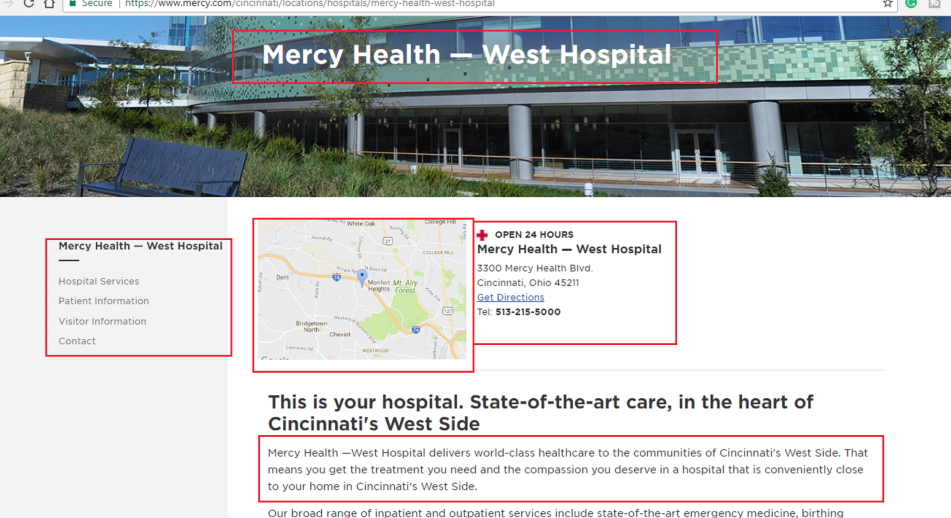
Now, this is exactly what you must aim to offer your readers with.
-
Integration of Information
For a website to catch the attention of the user and to keep him hooked, it is important to offer the information in its entirety, as is illustrated by the example given below. All the information regarding the product has been offered to the user, with the help of images, texts, infographics and special symbols. Even if you simply glance at the red boxes, you will be able to decipher about the product –
-
Name
-
Type
-
Features
-
Appearance
-
Pricing
-
Protection Plan
-
Shipping
-
User Ratings
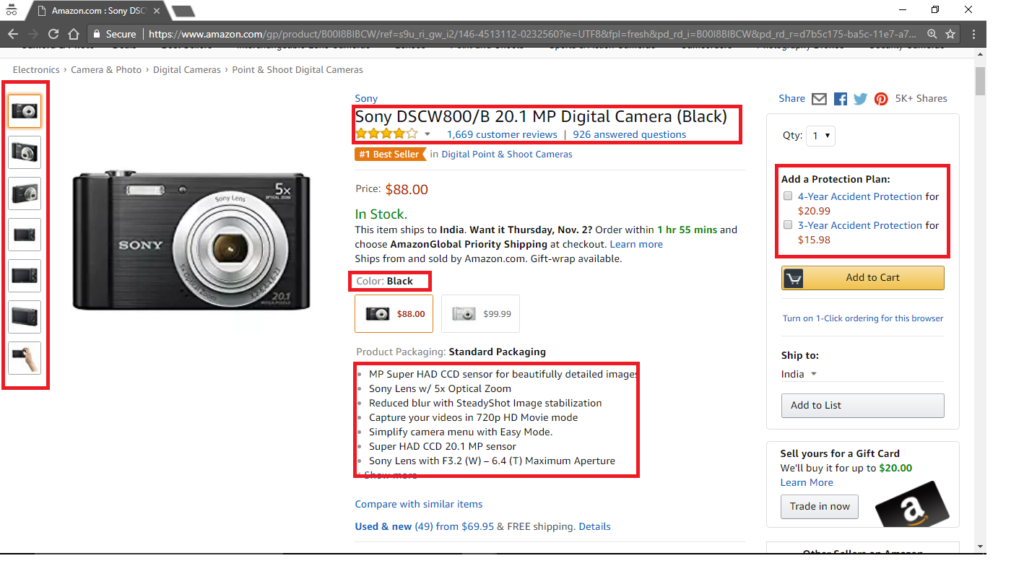
This is exactly the kind of comprehensive information that website owner should aim to offer the users with.
-
Inclusion of Components (Images/Graphics/Videos)
For all, we know images, infographics, videos and other such elements act as the eye-candy on a web page. It isn’t just that they enhance the visual appeal of the webpage, but also offers many other benefits such as –
-
Making the site easily comprehensible, even for young children who can’t read fluently or for elderlies, who don’t wish to take the painstaking efforts to read through every word.
-
Decreasing the bounce rate significantly.
-
Making the user believe that what he’s being offered is as interesting as the visuals that he’s witnessing.
-
Helping the site come across as modern and candid. Something that the user can place his trust in.
-
Assisting in generating greater sales due to added ease of use.
If studies are to be believed, every visual element placed on a webpage increases that chances of a sale, by an average of a whopping 16.5%.
-
Dynamic Content
This refers to the blogs, articles, and media related aspects such as press releases that are updated on the website on a regular basis. For all you know, the more a website keeps updating its dynamic content, the more it attracts users who are vying for information. In addition, this ensures that the website enjoys a higher rank on the SERPs. The precondition here is that the content must be unique, relevant and high-quality.
-
Keyword Diversity
As has been pointed out earlier in this article, it is in the best interest of a website to flaunt as many relevant keywords as it possibly can. Moreover, rather than sticking to one or two-word keywords, it is also beneficial for the site to incorporate the use of long tail keywords and phrases. For that matter, even modifiers prove to be of great help in ensuring that the content is both, SEO compliant as well as rich in quality.
Of course, all this must only be carried out, if it doesn’t affect the natural flow of language or the overall relevance of the content.
-
Learnings from Competitors
This is essentially a learning curve for both, new entrants in the online space as well as old players. No matter how good or great your web content is, there is always a chance to make it better. And this can be done with an impressive ease, simply by evaluating what the competitors are doing. You can do so by –
-
Reading their content
-
Evaluating what they’re doing extra
-
Understanding how their content is being shared – through social media/other channels such as emails
-
Evaluating their SERP ranging versus your own
-
Taking a note of the composition of their content
Here, the idea is not to beat the competition, but simply learn from them. If they’re better at doing something then, incorporate it. If you’re better at certain aspects, then make sure you work even harder on those so that you can become the best at it.
The Takeaway
Well, that was something. We understand if the above discussion seemed too overwhelming for you. But don’t you worry. Creating good content is not an overnight task. It requires
-
In-depth knowledge (which we are sure, you now have)
-
The right people – webmasters, developers, content creators and SEO specialists
-
Persistence
-
Perseverance
-
Consistent Efforts
Trust us, when we say, it is just the first step towards good content that will feel a little difficult. Once you embark on the journey of achieving high-quality content and simultaneously climb the ladder of higher rankings, all of this will seem like a child’s play. All you need to do is take one step after the other, and before you know it, your business will achieve the success that it truly deserves, and so will you!













